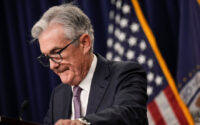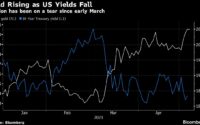Premarket stocks: The Fed is fighting inflation. Could deflation be its next battle?
That’s good news for cash-strapped consumers. But a drop in prices isn’t causing everyone on Wall Street to cheer. Some are starting to use the “D” word: deflation, another form of price instability that’s bad for the economy.
What’s happening: The headline number for the Consumer Price Index, a closely-watched inflation gauge, is expected to show that prices actually declined by 0.1% between July and August. (Forecasts still show an 8.1% increase over the past 12 months.)
That might sound like a good thing. But to some, it’s cause for concern.
Falling prices can indicate weak demand, and consumer spending is a big portion of the economy. Markets are skittish that the Fed’s actions — which take a while to feed through the system — could overshoot, sending the US economy into a prolonged and deep recession.
Deflation can prompt the opposite of what we’ve seen recently — a downward spiral in jobs and wages as companies cut back production and lay off staff.
What the market should remember: “Headline inflation” is called just that because it’s the measurement most commonly reported in the media and most familiar to Americans.
But the Fed doesn’t look at that number when determining monetary policy — it uses core inflation, which doesn’t include food or energy. That metric is expected to increase by 0.3% between July and August, according to Refinitiv. In fact, Powell has said repeatedly that energy prices are not something the Fed can control.
“I think a lot of investors react to headlines or the first paragraph of a story without really getting into the details, and there’s a lot of strong movement around the Fed. My strong suspicion is that most investors have never even watched a full [Federal Reserve] press conference,” Luke Tilley, chief economist at Wilmington Trust, told me.
And what of Musk and Wood’s proclamations on Twitter?
“They’re talking their books,” Vincent Reinhart, chief economist of Dreyfus-Mellon, told me. If you’re a mega equity investor like Elon Musk, you’re going to want the Fed to stop hiking.
Reinhart says he’s worried about the narrative for another reason. If market participants are wrongly led to believe that the Fed won’t tighten that much, then hikes are going to be very disruptive.
“The problem with Musk and Wood speaking this way is that they have a broader reach into society than the people who focus on central banks,” he said. “There’s a worry that other views will permeate, and they’re views that aren’t helpful.”
The bottom line: Inflation is still near historical highs, and nearly a dozen Fed officials were united in their message last week that rate hikes will continue into the foreseeable future. Core and headline inflation are still much higher year-over-year, and monthly trends are often just noise.
Financial institutions address gun violence
The US credit card industry is taking long-sought action on illegal gun sales.
The system will separately categorize sales at gun and ammunition stores, which can help track suspicious transactions of firearms and ammunition. Gun control activists say the change will help flag potential mass shooters and gun traffickers.
The International Organization for Standardization, based in Geneva, approved the code on Friday. Nearly every retail item has a merchant category code — but prior to Friday’s decision by the ISO, gun store sales were classified under a general merchandise or sporting goods category.
The proposal was first suggested by DealBook’s Andrew Ross Sorkin in 2018 following the Parkland shooting.
Visa reversed course last week. In a statement on Sunday the world’s largest payment network said it will “proceed with next steps while ensuring we protect all legal commerce on the Visa network in accordance with our long-standing rules.”
There have been 479 mass shootings in the US so far in 2022, according to Gun Violence Archive, a nonprofit research group.
Burger King wants to reign again
The company is playing a game of catchup against its competitors after missteps made during the pandemic caused it to lag behind other Fast Food kingdoms.
At the height of Covid-related closures, restaurants slimmed down menus and simplified their online ordering systems to meet greater demand. Burger King didn’t do that.
In the second quarter of this year, sales at Burger King US restaurants open at least 13 months grew by just 0.4%. Sales at McDonald’s US restaurants open at least 13 months jumped 3.7% in that period.
But there’s a turnaround plan: Burger King plans to remodel about 800 restaurants over the next two years. The fast food chain says it will invest $400 million in improving the brand — $250 million will go toward updating restaurant tech, kitchens and remodeling, and $150 million to advertising and digital products. Franchisees will also invest in improving the brand.
Up next
August US Consumer Price Index is released at 8:30 a.m. ET.
Also today →
Correction: An earlier version of this story misstated the number of days gas prices have fallen in the United States. Tuesday marked the 91st day in a row that prices fell.
[ad_2]
Source link
Related Posts

Fed Faces Tough Decisions as Inflation Lingers and Economic Risks Loom – DNyuz

Bank Run in Russia as People Try to Access Cash
